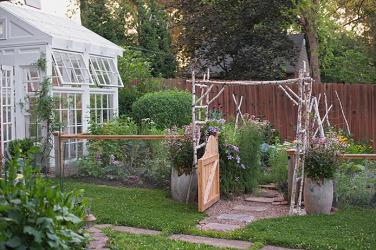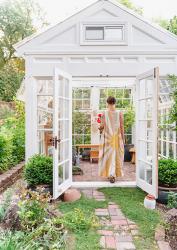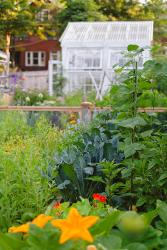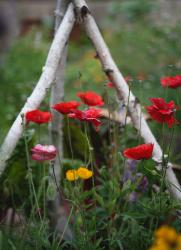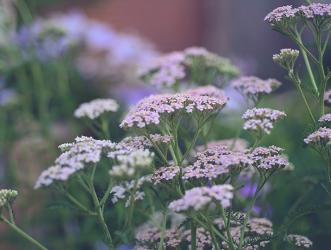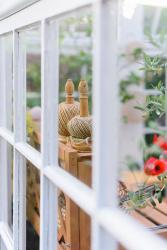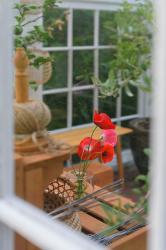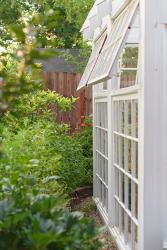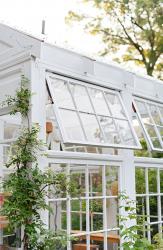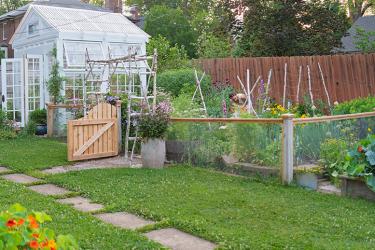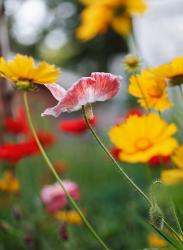If Beatrix Potter’s charming characters from the English countryside were to vacation in the United States, they would undoubtedly make a stop in Lauren Knight’s University City garden.
There is a cozy, cottage feel to the pathways and plantings that seems right out of an English storybook. Bright flowers overflow charming beds and mingle in joyful exuberance with a wide variety of garden vegetables. A mound of orange and gold nasturtiums cuddles up to the spear-like leaves of crinkled, gray-green Tuscan kale. Red and gold butterfly weed snuggles with the neon-bright stems and forest green leaves of rainbow chard. Adding to the country charm, arbors, trellises and tripods constructed from white birch poles (purchased at Greenscape Gardens) add structure to the landscape and support everything from the saucer-like, blue blossoms of vining clematis to the tiny tendrils of climbing peas. Creeping thyme meanders over pathways. “It can get pretty wild, but I like it,” says Lauren. “There is always something in bloom and it changes every three weeks.”
A white, solarium-style green house, constructed from the old wood windows discarded by a neighbor, is the perfect embellishment to the design of the garden. Lauren uses it to start seeds in the late winter and early spring and store supplies such as twine, flowerpots and vases in warmer months. “I like the continuity of the white of the poles and the white of the greenhouse throughout the garden,” Lauren notes.
The fact that visitors to her garden immediately see a cottage garden and think of Peter Rabbit and Beatrix Potter, Lauren takes as a compliment. “I am flattered by that,” she says. “I was raised on those books, and they seep into us without our knowing it. Children’s books had a big impact on my life.”
There are other comparisons that are easily made between Beatrix Potter and Lauren Knight. Both were heavily influenced by fathers who were photographers and interested in the natural world. Potter’s was a barrister who has been described as an “adept amateur photographer.” Lauren’s was an artist and professional photographer. “He taught me the basics of gardening,” she recalls. “I don’t think he was really talking to me. It is just that I was following him around and observing what he did and prioritizing how you spend your time. He spent a lot of time in the backyard. He was the vegetable gardener, and my mom was flowers.”
Both Beatrix and Lauren are artists as well. Beatrix wrote and illustrated over 60 books involving the natural world in the late 1800s and early 20th century. Best known are her 23 children’s books.
Lauren began painting just seven years ago, when she broke an ankle in a ballet class and “I couldn’t do anything physical. I was crawling out of my skin needing a creative outlet.” With the beauty of the garden calling, she decided to pick up a brush and record with paint what she had planted in the ground. She began by photographing what she wanted to paint and then transferring that photograph to a grid. These days she works freehand as well, using the grid for larger pieces. She already has found professional success. More information on her paintings is available at www.laurenknightart.com.
Her passion for gardening arose as an artistic outlet when her sons (now 16, 14 and 12) were babies. “At nap time I would leave the windows open so I could hear them and run outside. When they were toddlers, I would take them outside with me.” She recalls. Her gardening knowledge, as her painting expertise, has been accumulated through trial, error, and success. Her artist’s eye contributes to the design of the garden, which expanded greatly during the isolation of the Covid lockdown. “It was like having an oasis in my own back yard; the garden was a lifesaver,” she says. “I couldn’t imagine being isolated without any greenspace.”
Lauren is a firm believer in mixing flowers and vegetables not only for the beauty it offers but for the benefits it provides for the health of the plants. “With a greater variety of plants, you have fewer pests and fewer weeds,” she says. “For instance, umbrella-shaped flowers attract parasitic wasps. Those wasps go after tomato horn worms and cabbage moth larvae. Lady bugs, lace wings and praying mantises go after a lot of things you don’t want in your garden.”
In a Mr. McGregor-sympathetic move, attractive wire fencing, stabilized with wood, encloses a large area of her garden and keeps out rabbits. Cages cover tomatoes to keep squirrels away.
These days she is starting more and more plants from seed saved from what already grows. “They are the varieties that survived in this climate,” she notes. Poppies are one of her favorite flowers; “they give such a fairy tale look to the garden because they are so delicate.” But they can be tricky to grow. She has had success with successively sowing seeds directly in different parts of the garden in the fall, winter and spring and simply waiting to see what germinates, then thinning them if necessary. Other favorites are the bell-shaped blossoms of fox gloves for the English cottage look they bring, rainbow chard for the beauty of the multicolored stems and long season, which stretches from early spring into early winter, and Red Acre cabbage for its maroon beauty as well as its use in the kitchen. “I have a whole series of paintings just on those cabbages,” she notes.
To keep her soil producing at its best, Lauren adds a thick layer of leaf mulch and compost in the fall. “I don’t want anything uncovered in the winter,” she says.
In the summer Lauren begins her day in the early morning, watering her garden. “I’m an early riser and it’s actually relaxing,” she explains. “I see the hummingbirds and observe nature. I start the day in a positive way.”
That positivity extends to the whole gardening process, Lauren affirms. “I have tried different ways to meditate and yoga. They never worked for me. The only way to clear my mind and calm my nerves and be present in the moment was by being out in the garden. There is the physical work and then seeing the beauty and good things that result from that work. It is good for my soul, good for my mind and good for my body. Growing my food and feeding my family is the most satisfying thing in the world.” She is delighted that her youngest son, Emil, is showing signs of following in her gardening footsteps. “He is actually taking it in as I did as a kid. It is pretty monumental for me,” she continues.
His gardening patch is a bare area left when the family moved a trampoline. “I let him pick what he wanted to grow. He came up with nasturtiums because we like them for salads, sunflowers, dinosaur kale, snow peas, super pie pumpkins, cucumbers, strawberries, carrots and a tomato plant. We started things from seed in the greenhouse and he caught on right away. He had such a gentle touch when he transplanted seedlings. He was so proud when his cucumbers were better than mine and he could go out and harvest things for dinner. It is that sense of pride in growing food for your family that I want to instill.”


